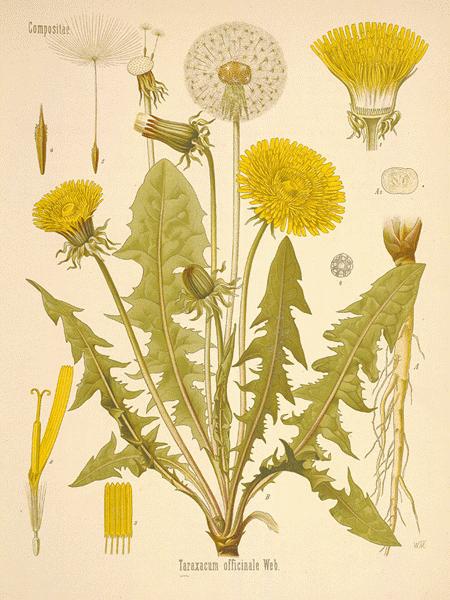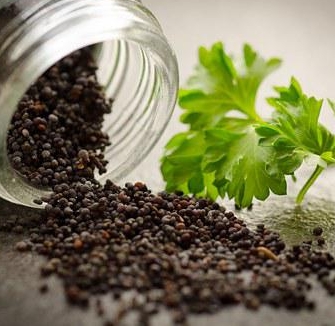The Dandelion plant is native to Eurasia, but is now widespread throughout the world (5). Known for being a weed, today it is often sprayed with pesticides to repress its growth; many people are unaware of its medicinal benefits.
The Chinese use the entire Dandelion plant for a liver tonic and a diuretic. They call it pu gong ying. The Native Americans use Dandelion for a variety of illness and the Greeks called dandelion taraxos achos “disorder remedy”(2).
Dandelion is a perennial and grows to be about 12in tall. It can be harvested during frost periods of the year (7).
I found dandelion to be a fascinating herb. I ate dandelion as a salad green, made a dandelion salve and drank dandelion as a tea.
When eating dandelion, I found it to give me a sort of positive motivating energy. It felt very clean and made me want to be active.
I made dandelion salve out of the flowering tops of the plant, sweet almond oil and beeswax. I really liked the way it softened my skin, as for a tension releaser I applied the salve to my shoulders where I tend to hold my stress and noticed the muscles relaxing after applying. I imagine the salve to be really good for someone with arthritis or other diseases that cause sore or tense muscles.
When making a tea with dandelion I used the root of the plant. After drinking the tea I felt an intense sensation of relaxation and I felt the tension leave my body. I also felt a feeling of becoming one with nature. It was a very comforting and positive experience for me.

(Image: https://www.botanical.com/botanical/mgmh/d/dandel08-l.jpg)
MATERIAL MEDICA: DANDELION
Latin name:Taraxacum officinale
Family: Asteraceae
- Leaf: The first green springtime leaves are often preferred because they are less bitter. Those seeking the beneficial bitter flavor can harvest all season. Simply cut the entire crown at ground level.
- Root: Harvest the taproot between in the spring for bitter roots and in the fall for sweeter roots, using a digger tool to extract the entire root from the ground. Scrub well. The herb may be slice from top to bottom and laid out to dry, but others prefer to dry the root whole to preserve the latex.
- Flower: Pop off the open yellow flower, leaving the green sepal behind if you would like to avoid their bitter flavor.
Leaf – Bitter, Slightly sweet, Slightly salty
Root – Bitter, Slightly sweet
Preparations and dosage:
- Root tincture: 2-5 mL 3x/day (1:5 in 60%).
- Root decoction: 2-3 teaspoons simmered in water for 10-15 minutes 3x/day Leaf tincture: 5-10 mL 3x/day (1:5 in 50%).
- Leaf infusion: 1-2 teaspoons dried leaf infused in 1 cup hot water for 15 minutes, 3x/day.
- Fresh leaves can also be eaten steamed or raw.
- Salve-Dandelion flowering tops, beeswax and oil
- Dosage information from Medical Herbalism by David Hoffmann.
Uses:
Dandelion is known for being a liver and kidney tonic. It aids digestion, helps with breast tumors, abscesses, boils, fluid retention, stomach disorders and constipation. (1). It is one of the best remedies for hepatitis and potentially a preventative for breast cancer.
Emotionally releases tension, balances and puts one more in tune with self.
Studies have proven Dandelions affects on reducing inflammation and increasing bile production. A study done on mice has shown dandelion extract to up-regulate estrogen, progesterone and follicle-stimulating hormone receptors in mine (6). Another study showed a 32% success rate in curing Hepatitis B, meaning the Hepatitis B virus DNA became negative (6).
Cautions:
Dandelion has very few reported cases of contraindications. As with any plant there is the potential of an allergic reaction (5).
There have been few cases of Dandelion causing abdominal discomfort, loose stools, nausea and heartburn (5).
Sources:
- Tierra, Michael, and David Frawley. Planetary Herbology: An Integration of Western Herbs into the Traditional Chinese and Ayurvedic Systems. Twin Lakes, WI: Lotus, 1988. Print.
- Edwards, Gail Faith. Opening Our Wild Hearts to the Healing Herbs. Woodstock, NY: Ash Tree Pub., 2000. Print.
- Moore, Michael. Medicinal Plants of the Mountain West. Santa Fe: Museum of New Mexico, 2003. Print.
- Kaminski, Patricia, and Richard Katz. Flower Essence Repertory: A Comprehensive Guide to North American and English Flower Essences for Emotional and Spiritual Well-being. Nevada City, CA: Flower Essence Society, 1994. Print.
- Mars, Brigitte. The Desktop Guide to Herbal Medicine: The Ultimate Multidisciplinary Reference to the Amazing Realm of Healing Plants, in a Quick-study, One-stop Guide. Laguna Beach, CA: Basic Health Pub., 2007. Print.
- Yarnell, E., and K. Abascal. “Dandelion (Taraxacum Officinale and T Mongolicum).” Integrative Medicine: A Clinician’s Journal (2009): 34-36. Web.
- Latona, Brita “Materia Medica Dandelion Lecture” April 30, 2015.
- Herbarium’s Dandelion Monograph


